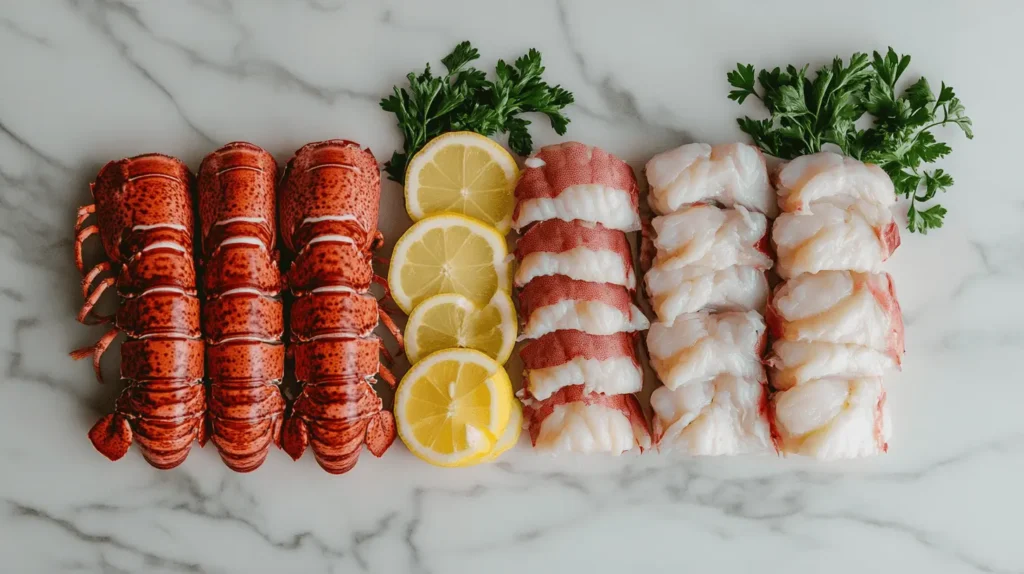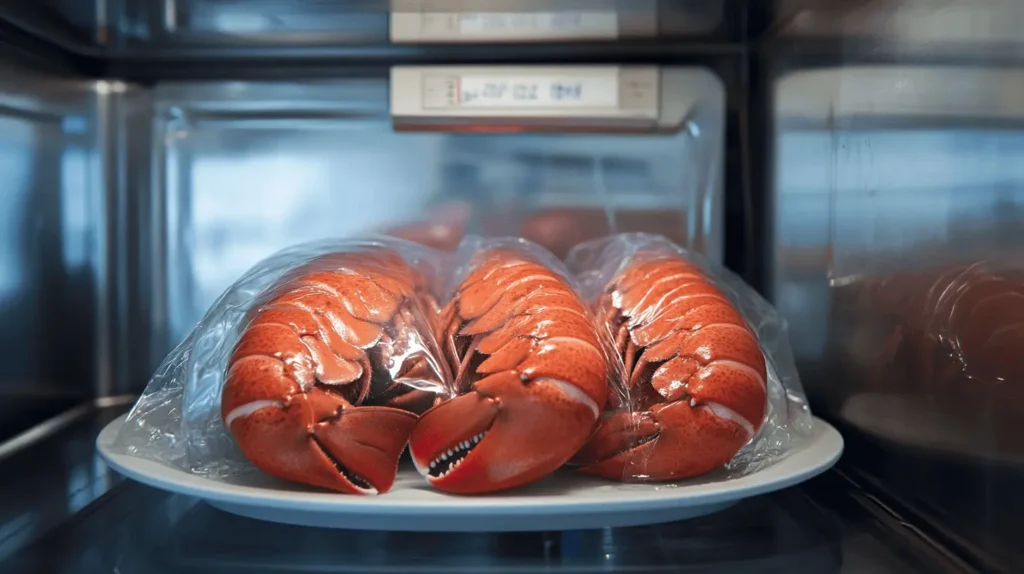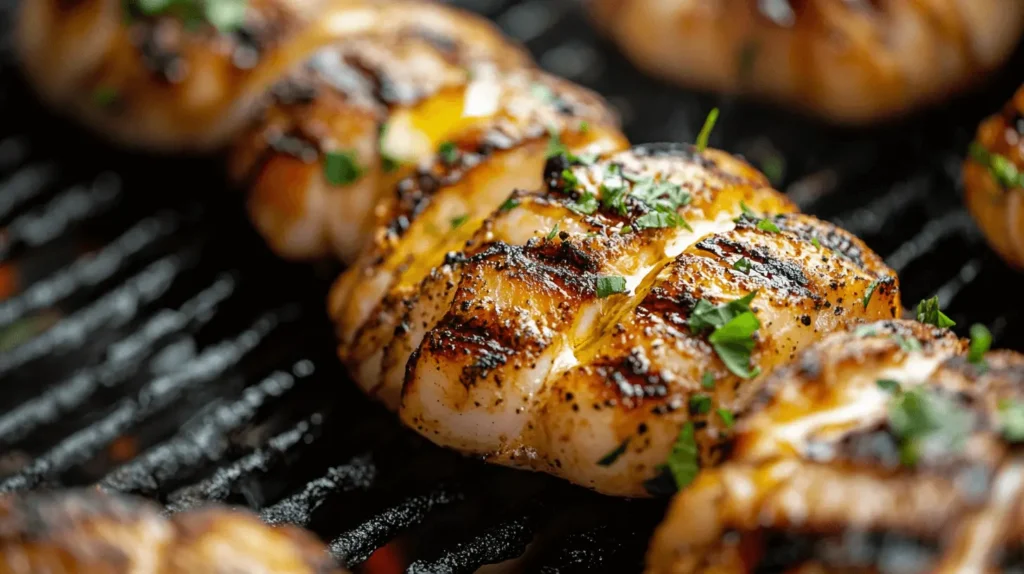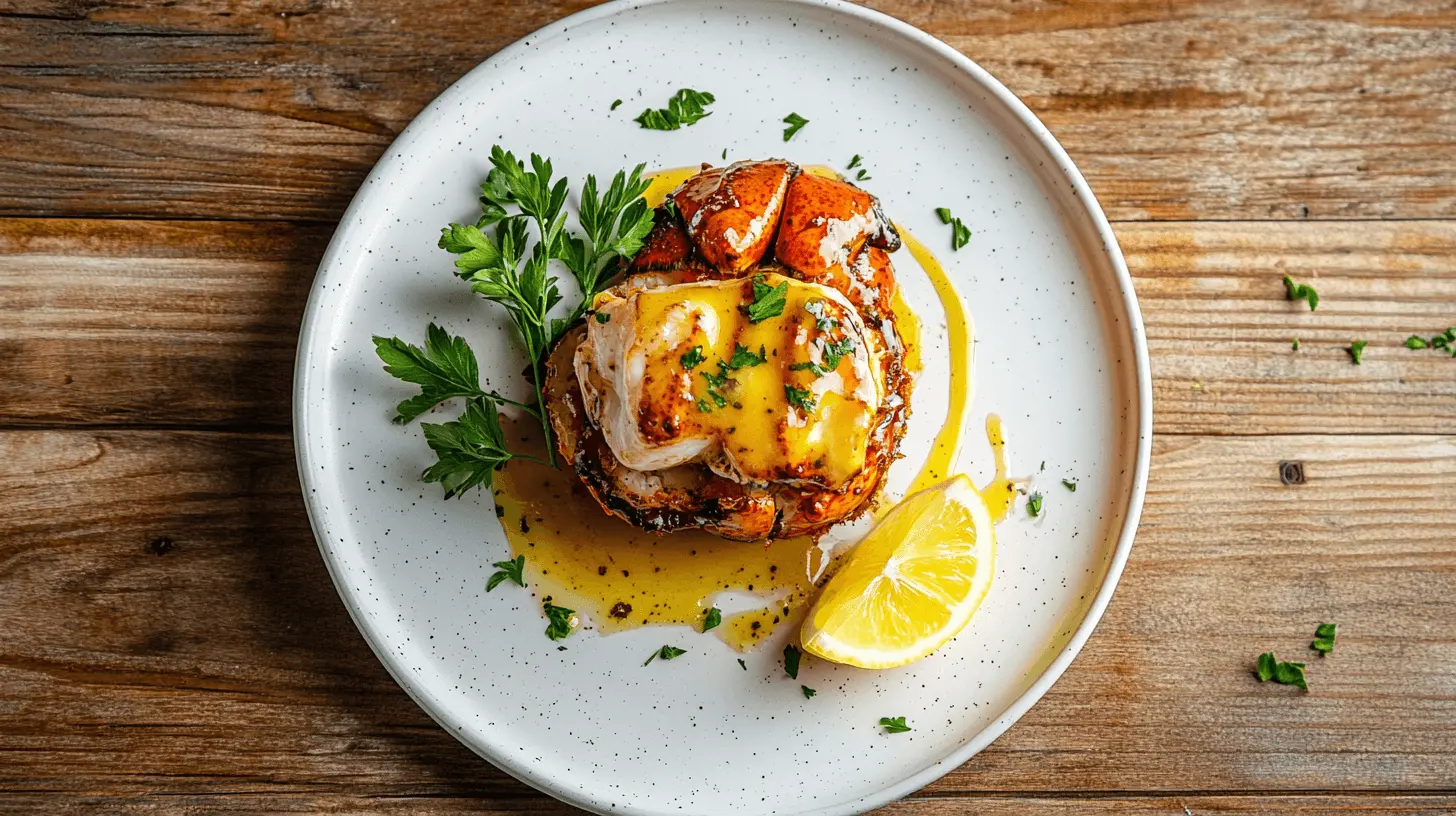Introduction to Lobster Tails
Lobster tails are a luxurious seafood delicacy prized for their tender, succulent meat and sweet flavor. Whether served as the centerpiece of a gourmet meal or as an indulgent treat, they epitomize elegance and culinary excellence.
Why Lobster Tails Are a Delicacy
Lobster tails are considered a delicacy due to their rich, buttery flavor and versatile preparation methods. Harvested from the spiny or clawed varieties of lobster, the tail offers the densest, most flavorful meat. Their status as a luxury food stems from their limited availability and the labor-intensive process of harvesting, making them a sought-after treat for special occasions.
Frozen Lobster Tails vs. Fresh Lobster Tails

When choosing lobster tails, you’ll often face the decision between frozen and fresh. Each has its advantages, depending on your needs and location.
- Frozen Lobster Tails: Convenient and widely available, frozen lobster tails are flash-frozen shortly after harvest to preserve their quality. They allow for longer storage and are an excellent option if fresh tails are unavailable. However, they must be thawed and cooked carefully to retain their texture and flavor.
- Fresh Lobster Tails: Fresh tails are prized for their superior taste and texture, as they have not undergone freezing. However, they are highly perishable, expensive, and may only be accessible in coastal areas or seafood markets. For the best results, fresh lobster tails should be cooked soon after purchase to maintain their quality.
Understanding the differences between frozen and fresh lobster tails can help you choose the best option to suit your recipe and occasion.
For more insights on cooking frozen lobster tails, explore our detailed guide: How To Cook Frozen Lobster Tails: Easy Methods And Recipes.
Importance of Proper Defrosting
Defrosting lobster tails correctly is a critical step in ensuring a delightful dining experience. Improper defrosting can negatively impact the texture, flavor, and safety of the seafood, diminishing its quality and posing health risks.
Preserving Texture and Flavor
Lobster tails are known for their tender, succulent meat, and improper defrosting can compromise these desirable qualities. Gradual defrosting allows the meat to retain its natural moisture, resulting in a firmer and juicier texture after cooking. Rapid defrosting, such as using warm water or a microwave, can lead to uneven thawing, causing parts of the meat to become mushy or overcooked during preparation.
Proper defrosting also helps preserve the sweet, delicate flavor of lobster tails, ensuring they taste as fresh as possible when cooked.
Ensuring Food Safety During Defrosting
Safe defrosting practices are essential to minimize the risk of bacterial growth, which can occur when seafood is left at unsafe temperatures. The safest methods for defrosting lobster tails include:
- Refrigerator Thawing: Place the lobster tails on a plate or in a sealed bag and let them defrost slowly in the refrigerator for 24 hours. This method keeps the tails at a consistent, safe temperature.
- Cold Water Thawing: If time is limited, seal the lobster tails in a waterproof bag and submerge them in cold water. Change the water every 30 minutes to maintain a cold temperature until the tails are thawed.
Avoid defrosting at room temperature, as this creates a favorable environment for bacteria to grow. By prioritizing proper defrosting techniques, you can ensure both the safety and quality of your lobster tails.
Methods to Defrost Lobster Tails
Defrosting lobster tails properly ensures their quality, safety, and delicious flavor. Various defrosting methods are available, each suited to different situations based on time and resources.
Overview of Defrosting Techniques
Here are the most common methods for defrosting lobster tails:
- Refrigerator Thawing: This is the safest and most effective method. Place the lobster tails on a plate or in a sealed container and let them thaw slowly in the refrigerator. This process typically takes about 24 hours.
- Cold Water Thawing: For a quicker option, seal the lobster tails in a waterproof plastic bag and immerse them in cold water. Change the water every 30 minutes to maintain a safe temperature. This method can defrost tails in 1–2 hours.
- Microwave Defrosting: Though not recommended, some microwaves have a defrost setting. However, this method risks uneven thawing and can partially cook the meat, affecting texture and flavor. Use only in emergencies and monitor carefully.
Choosing the Best Method for Different Situations
The ideal defrosting technique depends on your time constraints and the condition of the lobster tails.
- For Planned Meals: If you have sufficient time, refrigerator thawing is the best choice, as it preserves texture and flavor while ensuring food safety.
- For Last-Minute Preparation: Cold water thawing is effective for defrosting lobster tails quickly without significantly compromising quality.
- In Emergencies: If you’re pressed for time, microwave defrosting can be used cautiously, but it’s essential to stop before the tails begin to cook.
By selecting the appropriate defrosting method for your needs, you can maintain the premium quality of lobster tails and prepare them perfectly for cooking.
Refrigeration Method
The refrigeration method is the gold standard for defrosting lobster tails, ensuring optimal texture and flavor while maintaining food safety. This slow and steady approach is perfect for planned meals where time allows for proper thawing.

Step-by-Step Guide
- Preparation: Remove the lobster tails from their packaging and place them on a plate or shallow tray to catch any liquid that may drip during thawing.
- Cover: Cover the tails loosely with plastic wrap or foil to protect them from absorbing refrigerator odors.
- Refrigerate: Place the plate or tray in the refrigerator. Ensure the temperature is set to 40°F (4°C) or below.
- Wait: Allow the lobster tails to defrost gradually. This process typically takes about 24 hours for most sizes.
- Check: Once fully thawed, the lobster tails should feel pliable but still cold. Cook them immediately or keep them refrigerated until ready to use.
Pros and Cons of Refrigeration Defrosting
Pros:
- Preserves Quality: Gradual thawing helps maintain the lobster’s natural texture and flavor.
- Ensures Food Safety: Keeps the tails at a consistently safe temperature, reducing the risk of bacterial growth.
- Hands-Off Process: Requires minimal supervision once the tails are placed in the refrigerator.
Cons:
- Time-Consuming: Requires advance planning, as it takes up to 24 hours to fully defrost.
- Refrigerator Space: May take up valuable space in the refrigerator, especially if defrosting multiple tails.
By following these steps and understanding the pros and cons, you can confidently use the refrigeration method to achieve the best results when preparing lobster tails.
Cold Water Method
The cold water method is a faster alternative for defrosting lobster tails while still maintaining quality and safety. This technique is ideal when you need to defrost seafood quickly without compromising texture or flavor.
How to Safely Use Cold Water
- Seal the Lobster Tails: Place the lobster tails in a sturdy, leak-proof plastic bag to prevent water from coming into contact with the meat, which could affect its texture and taste.
- Prepare a Cold Water Bath: Fill a large bowl or basin with cold water. Avoid using warm or hot water, as it can encourage bacterial growth and partially cook the lobster.
- Submerge the Bag: Place the sealed bag of lobster tails in the cold water, ensuring they are fully submerged.
- Change the Water Regularly: Replace the water every 30 minutes to maintain a consistently cold temperature.
- Check for Doneness: The lobster tails should defrost within 1–2 hours, depending on their size. Once thawed, cook immediately or keep refrigerated until ready to use.
Tips for Preventing Contamination
- Use a Sealed Bag: Ensure the bag is completely sealed to prevent water from seeping in and contaminating the lobster meat.
- Keep Work Surfaces Clean: Sanitize the area where you’re working with the lobster tails to avoid cross-contamination.
- Monitor the Temperature: Ensure the water stays cold throughout the process to minimize the risk of bacterial growth. If the water feels warm, replace it immediately.
- Avoid Refreezing: Once thawed, do not refreeze the lobster tails, as this can compromise their quality and safety.
By following these steps and precautions, the cold water method can be a safe and effective way to defrost lobster tails quickly without sacrificing their premium quality.
Microwave Defrosting
Microwave defrosting is the quickest way to thaw lobster tails, but it requires careful attention to avoid uneven thawing or partial cooking. While this method can be convenient in emergencies, it is less ideal compared to other defrosting techniques.
Using the Defrost Setting Effectively
- Prepare the Lobster Tails: Remove any packaging and place the lobster tails on a microwave-safe plate.
- Cover: Cover the tails loosely with a microwave-safe lid or wrap to prevent splattering and retain moisture.
- Set the Microwave: Use the defrost setting, which operates at a lower power level to prevent cooking. If your microwave doesn’t have a defrost option, set it to 30% power.
- Defrost in Short Intervals: Heat the lobster tails in 30-second intervals, flipping them after each interval to ensure even thawing.
- Monitor Closely: Stop as soon as the tails are pliable but still cold. Avoid leaving them in the microwave for too long, as this can partially cook the meat and affect texture.
- Cook Immediately: Once defrosted, cook the lobster tails immediately to maintain their quality.
Why Microwaving Is Less Ideal
- Risk of Uneven Thawing: Microwaves often heat unevenly, leading to some parts of the lobster being partially cooked while others remain frozen.
- Texture and Flavor Impact: Partial cooking during defrosting can alter the delicate texture and flavor of the meat.
- Limited Control: Unlike other methods, microwaving offers less precision, making it easier to overheat or damage the meat.
Microwave defrosting should only be used as a last resort when time constraints make other methods impractical. With careful monitoring, it can work in a pinch, but it’s best to rely on refrigeration or cold water thawing for superior results.
Common Mistakes to Avoid
Proper defrosting of lobster tails is crucial to ensure the best flavor, texture, and safety. However, mistakes during the process can compromise the quality of the seafood or even pose health risks. Below are two common errors to avoid.
Defrosting at Room Temperature
Defrosting lobster tails at room temperature may seem convenient, but it is highly unsafe.
- Risk of Bacterial Growth: Leaving lobster tails at room temperature allows them to stay in the “danger zone” (40°F–140°F or 4°C–60°C) where bacteria multiply rapidly. This can lead to foodborne illnesses.
- Uneven Thawing: External layers of the lobster may thaw while the interior remains frozen, leading to inconsistent cooking later.
- Texture Compromise: Rapid temperature changes at room temperature can negatively affect the texture, making the meat less firm and succulent.
To ensure food safety, always defrost lobster tails in the refrigerator or using the cold water method.
Rushing the Process
Attempting to speed up defrosting by using hot water, leaving the tails under direct heat, or microwaving improperly can damage the quality of the meat.
- Hot Water Thawing: Using warm or hot water to defrost lobster tails might seem like a quick fix, but it partially cooks the meat and creates an uneven texture.
- Improper Microwave Use: Skipping intervals or using high power settings in the microwave can lead to overcooked spots, affecting flavor and presentation.
- Skipping Steps: Neglecting to replace cold water during the cold water method or failing to monitor microwave defrosting can result in subpar outcomes.
Patience is key when defrosting lobster tails. Allowing the tails to thaw gradually ensures optimal flavor, texture, and safety, making the extra time well worth it.
Cooking Lobster Tails After Defrosting
Once your lobster tails are properly defrosted, it’s time to prepare them for cooking. Proper preparation and selecting the right cooking method ensure you get the best flavor and texture from your seafood.
Prepping the Lobster Tails
- Rinse and Pat Dry: After defrosting, rinse the lobster tails under cold water to remove any residual ice or juices. Pat them dry with a paper towel.
- Butterfly the Tails: For even cooking and a beautiful presentation, consider butterflying the lobster tails. Using kitchen shears, cut through the top shell lengthwise, stopping just before the tail. Gently pull the meat upward, letting it rest on top of the shell while keeping it attached.
- Season: Brush the lobster meat with melted butter, olive oil, or a marinade of your choice. Sprinkle with seasonings like salt, pepper, paprika, garlic powder, or fresh herbs to enhance the flavor.
- Prepare Equipment: Depending on the cooking method, preheat your grill, bring water to a boil, or set up your steamer.
Best Cooking Methods
Each cooking method highlights the natural sweetness and tenderness of lobster tails in unique ways.
1. Boiling
- How to Cook: Bring a large pot of salted water to a boil. Add the lobster tails and cook for about 1 minute per ounce of tail weight. Remove when the meat is opaque and white.
- Best For: Quick, simple preparation that maintains the meat’s juiciness.
- Tip: Serve with melted butter or lemon wedges for a classic pairing.
2. Grilling
- How to Cook: Preheat the grill to medium-high heat. Place butterflied lobster tails meat-side up and grill for 5–8 minutes, brushing with butter or marinade. Flip and cook for another 2–3 minutes until the meat is opaque.
- Best For: Smoky, charred flavors and a slightly firmer texture.
- Tip: Keep an eye on the tails to avoid overcooking, which can make the meat tough.
For a step-by-step guide on grilling lobster tails, check out our detailed recipe: Grilled Lobster Tails with Garlic Butter.

3. Steaming
- How to Cook: Bring about 2 inches of water to a boil in a pot with a steamer basket. Place the lobster tails in the basket, cover, and steam for 6–10 minutes, depending on their size. The meat should be opaque and tender.
- Best For: Preserving natural sweetness and tenderness with a delicate texture.
- Tip: Add aromatics like lemon slices, bay leaves, or garlic to the water for additional flavor.
By preparing and cooking lobster tails with care, you can create a gourmet meal that highlights their luxurious taste and texture.
Frequently Asked Questions
Can You Cook Lobster Tails Without Defrosting?
Yes, you can cook lobster tails without defrosting, but it’s not ideal. Cooking frozen lobster tails may result in uneven cooking, with the exterior overdone and the interior undercooked. If you’re short on time, boiling is the best method for cooking directly from frozen, as it allows the meat to cook more evenly.
How Long Does It Take to Defrost in the Fridge?
Defrosting lobster tails in the refrigerator typically takes about 24 hours, depending on their size. Larger tails may require slightly longer, while smaller ones may thaw more quickly. Always place the tails on a plate or tray to catch any drips during defrosting.
Are Frozen Lobster Tails as Good as Fresh Ones?
Frozen lobster tails can be as good as fresh ones if they are properly frozen shortly after harvest. Flash-freezing helps preserve the lobster’s texture and flavor. However, fresh tails have a slight edge in quality, especially if sourced directly from a reputable supplier and cooked promptly.
Can You Refreeze Lobster Tails?
Refreezing lobster tails is not recommended. Once thawed, the texture and flavor may deteriorate with refreezing, and there’s an increased risk of bacterial growth if they were not thawed under safe conditions. To minimize waste, only defrost the amount you plan to use.
Conclusion
Preparing lobster tails can seem daunting, but with proper defrosting and cooking techniques, you can create a meal that is both delicious and safe.
Recap of Key Points
- Proper defrosting is essential for preserving the texture, flavor, and safety of lobster tails. The refrigerator and cold water methods are the most reliable, while microwave defrosting should be used sparingly.
- Avoid common mistakes like defrosting at room temperature or rushing the process, as these can compromise quality and safety.
- Once defrosted, prepare the lobster tails by butterflying them and seasoning to taste. Choose a cooking method that complements your preferences, whether it’s boiling, grilling, or steaming.
- Frozen lobster tails, when properly handled, can be just as satisfying as fresh ones, making them a convenient and accessible option.
Encouragement to Enjoy Delicious, Safely Prepared Lobster Tails
With these tips and methods in mind, you’re ready to prepare lobster tails like a pro. Whether you’re hosting a special dinner or treating yourself to a gourmet experience, safely prepared lobster tails will elevate your meal. Take your time, enjoy the process, and savor the luxurious flavor of perfectly cooked lobster tails. Bon appétit!
To complement your lobster tail dish, consider these side options: What To Serve With Lobster Tails?.

